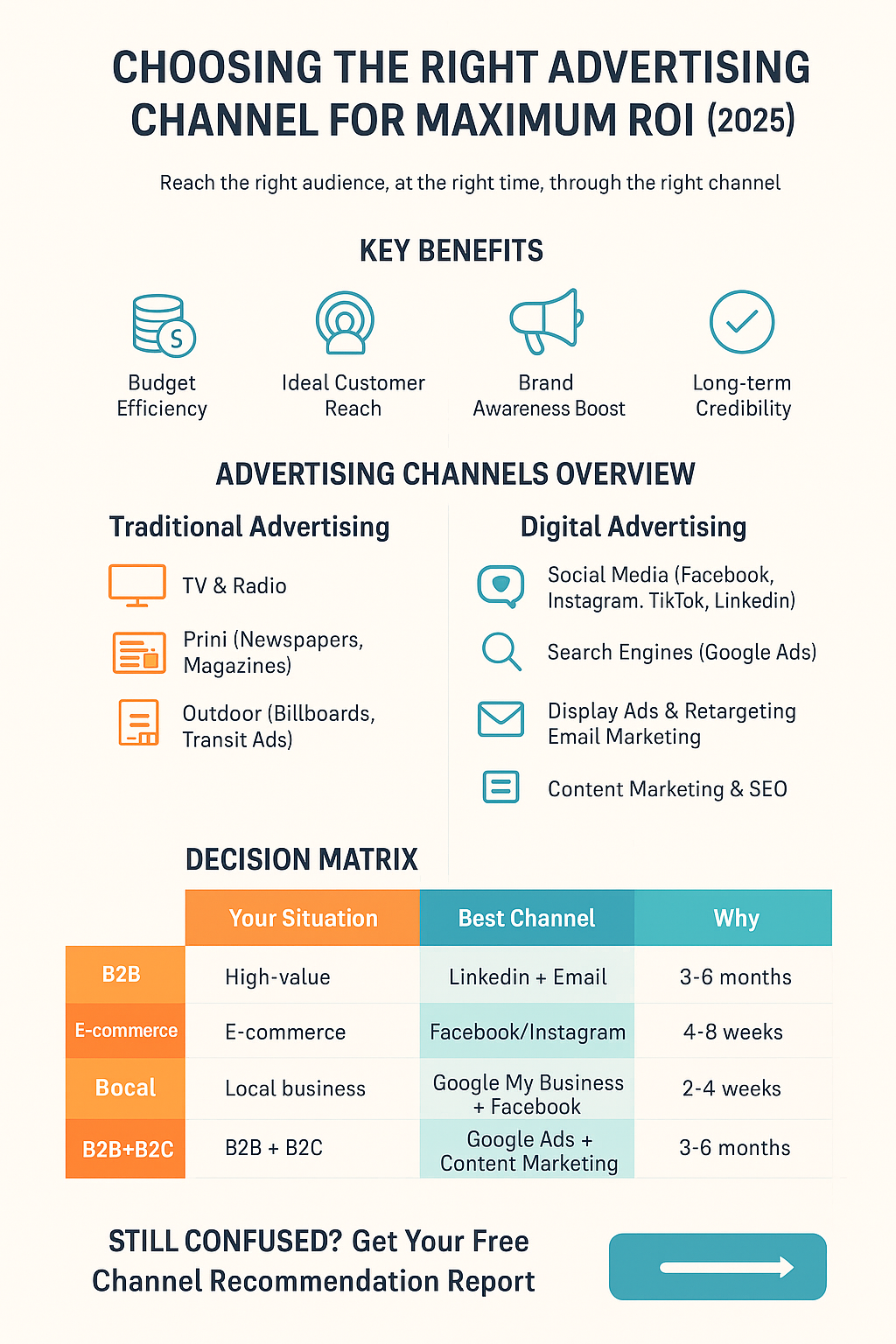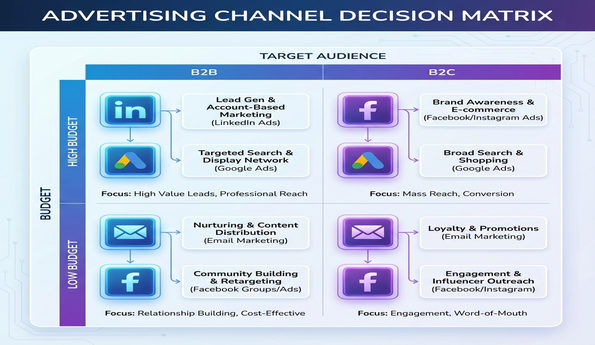How to Choose the Right Advertising Channel for Maximum ROI

Senior WebCoder

In today’s highly competitive market, simply having a great product or service isn’t enough. Reaching the right audience, at the right time, through the right channel, is what drives real business growth. With so many advertising platforms—traditional and digital—available today, businesses often struggle with one crucial question: “Which advertising channel is right for me?”
Choosing the right advertising channel can make the difference between wasted ad spend and a successful, high-ROI campaign. In this blog, we’ll break down how to evaluate advertising channels, explore the pros and cons of different types, and provide a step-by-step framework to help you make the best decision for your business.
Visual Guide: Choosing Your Advertising Channel

Infographic: How to Choose the Right Advertising Channel for Maximum ROI (2025)
Why Choosing the Right Channel Matters
Every business has limited resources—time, money, and energy. Selecting the wrong channel can result in poor targeting, lower engagement, and reduced returns. The right channel, however:
- Maximizes your budget efficiency.
- Connects you with your ideal customers.
- Boosts brand awareness and sales.
- Builds long-term credibility.
👉 Example: A local bakery may benefit more from geo-targeted Facebook ads and flyers in the neighborhood than from a national TV ad. On the other hand, a tech startup seeking global reach might gain better traction through LinkedIn campaigns or Google Ads.
Key Factors to Consider Before Choosing a Channel
1. Define Your Goals
Ask yourself: What do I want to achieve?
- Brand awareness → TV, radio, billboards, social media.
- Lead generation → Google Search Ads, LinkedIn, email marketing.
- Sales conversions → Retargeting ads, Instagram shopping, affiliate marketing.
- Customer loyalty → Email campaigns, community groups, loyalty programs.
2. Know Your Audience
Who are you trying to reach?
- Demographics: Age, gender, location, income.
- Interests: Hobbies, lifestyle choices, values.
- Behaviors: Where do they spend time online? Do they watch TV? Are they commuters?
👉 Example: If your target audience is Gen Z, TikTok and Instagram may be ideal. If your audience is B2B professionals, LinkedIn or industry magazines may work better. LinkedIn is ideal. Read our complete LinkedIn Ads guide.
3. Budget Constraints
- Traditional advertising (TV, radio, print) often requires higher upfront investment.
- Digital ads can start small and scale with results.
- Balance your budget with expected ROI.
4. Industry and Competition
- Study where your competitors are advertising.
- This doesn’t mean you should copy them, but it gives insights into what works in your industry.
5. Message and Format
- Some messages work better visually (Instagram).
- Some work best through storytelling (blogs, YouTube).
- Others thrive in short bursts (Twitter/X).
Choose the channel that fits your creative style.
Types of Advertising Channels
1. Traditional Advertising
- TV & Radio: Great for mass awareness, but expensive.
- Print (newspapers, magazines): Effective for local audiences or niche industries.
- Outdoor (billboards, transit ads): High visibility, but low targeting.
2. Digital Advertising
- Social Media (Facebook, Instagram, TikTok, LinkedIn, Twitter/X): Strong targeting, affordable, great for engagement.
- Search Engines (Google Ads, Bing Ads): Intent-driven, perfect for capturing active buyers. Google Ads delivers fast results. See our PPC guide.
- Display Ads & Retargeting: Keeps your brand top-of-mind for people who’ve already interacted with you.
- Email Marketing: Cost-effective, excellent for nurturing leads.
- Content Marketing & SEO: Long-term channel, builds trust and organic traffic.
Step-by-Step Framework to Choose the Right Channel
- Clarify Objectives – Awareness, leads, sales, retention.
- Map Audience to Channels – Where do they spend time?
- Analyze Budget vs ROI Potential – Choose scalable channels first.
- Test Multiple Channels – Start small with A/B testing.
- Measure & Optimize – Use KPIs like CTR, CPC, conversion rate, and customer acquisition cost.
Decision Matrix: Find Your Best Advertising Channel

| Your Situation | Best Channel | Why | Time to Results |
|---|---|---|---|
| B2B, high-value | LinkedIn + Email | Targets decision-makers | 3-6 months |
| E-commerce, impulse | Facebook/Instagram | Visual, fast-acting | 4-8 weeks |
| Local business | Google My Business + Facebook | Local reach, reviews | 2-4 weeks |
| B2B + B2C | Google Ads + Content Marketing | Covers all angles | 3-6 months |
By Your Industry:
FOR SAAS/SOFTWARE COMPANIES:
- Best channels: LinkedIn Ads, Google Ads, Content Marketing
- Why: Complex product needs education
- Budget: $1,000-5,000/month
FOR E-COMMERCE:
- Best channels: Facebook/Instagram, Google Shopping, Email
- Why: Visual products, retargeting works
- Budget: $500-2,000/month
FOR LOCAL RETAIL:
- Best channels: Local SEO, Facebook Ads, Flyers
- Why: Geo-targeted, builds community awareness
- Budget: $200-1,000/month
📥 DOWNLOAD: "Channel Selection Worksheet"
Answer our quick questions and get your recommended channels + budget allocation guide.
Still Confused About Which Channel to Choose?
Don't waste money on the wrong platforms. Let our digital marketing experts analyze your business and recommend the perfect channel mix.
👉 Get Your Free Channel Recommendation Report
Answer 5 quick questions, and we'll send you a personalized report with our top 3 recommended channels for your business.
Or schedule a consultation to discuss in detail.
Final Thoughts
There is no “one-size-fits-all” advertising channel. The best choice depends on your business goals, audience, and resources. Start by identifying your objectives, understanding your target audience, and testing a mix of channels. Over time, data-driven insights will reveal which platforms deliver the highest ROI.
💡 Remember: The right advertising channel is not the one with the loudest voice, but the one that speaks directly to your customers.
